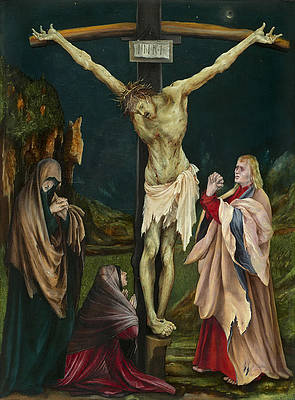“The Small Crucifixion” by Mattias Grunewald (1515)
https://www.nga.gov/collection/art-object-page.46118.html

Grunewald provides a stark, scripturally accurate portrayal of the crucifixion. The Lord is deceased as noted in the gray ashen color of His flesh. His head is hung low and mouth agape with no evidence of life. His hands offer curled fingers resulting from the weight of His body pulling at the nails and distorting the tendons and bones. The crown of thorns and the fragments from the tips of the cat-o-nine tail’s leather straps reveal the abuse. Open wounds stripe His side where the cat-o-nine tails reached. The knees are twisted at disturbing angles. God’s response is also evident.
The sky has turned dark, note the sun peering through the darkness, right top. An undisclosed light is shining on the scene and the vibrant colors of life are seen behind the cross. Mary Magdalene kneels before Jesus while Mary, the Mother of God, bows her head, unable to behold the scene. John, “the disciple Jesus loved,” (John 13:23) clenches his hands simultaneously in prayer and as if seeking mercy from the heart ache before him.
Jesus is portrayed by Grunewald as much larger than the other figures. His feet are only a couple of feet of the ground, yet His head is much higher than that, giving the imagery of Jesus being the enlarged focus of the painting. “INRI” written on the sign above the Lord’s head is the acronym for the Latin words representing “Jesus of Nazareth, King of the Jews.”
Grunewald reportedly said every believer who revels in the Lord’s triumphs must also suffer the Lord’s death in order to fully appreciate what has been done for them. This painting invites us to participate in that grief.